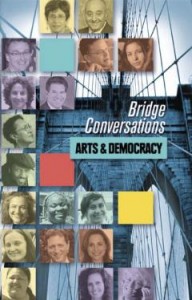Some great new publications on cultural organizing have come out recently, and they’ve helped me beef up my collection of cultural organizing definitions. If you look closely you can see some significant differences in how it is being conceptualized. Please share others if you know of them!
Definitions of Cultural Organizing
“Cultural organizing exists at the intersection of art and activism. It is a fluid and dynamic practice that is understood and expressed in a variety of ways, reflecting the unique cultural, artistic, organizational, and community context of its practitioners. Cultural organizing is about integrating arts and culture into organizing strategies. It is also about organizing from a particular tradition, cultural identity, community of place, or worldview.”
Dudley Cocke, Roadside Theater
“Cultural organizing means putting culture, including its concentrated expression of art
at the center of a social and political organizing strategy.”
Ebony Golden, Betty’s Daughter Arts Collaborative
“Cultural organizing is the strategic use of art and culture to shift policies and practices most impacting marginalized people…Practiced in communities since the beginning of time, cultural organizing honors the traditions, knowledge, practices, beliefs, ways of healing, cooking, worshiping that formed and maintained communities during times of abundance and prosperity as well as trauma and despair.”
Highlander Research and Education Center, Zilphia Horton Cultural Organizing Project
“The strategic use of art and culture to promote progressive policies with marginalized communities.”
Jan Cohen-Cruz, author of Engaging Performance, Theatre
as Call and Response
“Various forms of artistic communication that provide a cultural dimension to community organizing in order to expand and humanize a social movement.”
Joe Street, author of The Culture War in the Civil Rights
Movement
“When activists made an explicit attempt to use cultural forms or expressions as an integral, perhaps even dominant, part of the political struggle and when, during this process, attention was drawn to the intrinsic political meaning of the cultural activity.”
Tamejave Cultural Organizing Fellowship
“A community-building process in which people share cultural traditions and artistic expression with one another to build stronger, more active communities.”
“A practice that fuses arts, culture, and political organizing. Cultural organizing seeks to organize politically engaged artists together into networks of collaboration, and form intentional, cohesive partnerships between artists and like-minded advocacy organizations, funders, and political campaigns. Cultural organizing builds the power and capacity of artists as a community, both as skilled workers whose labor has value and as essential partners in the progressive movement.”





 A&D is a project of State Voices, which
builds networks among progressive grassroots organizations. It was founded in 2005,
emerging from a major voter registration initiative, and is directed by Caron Atlas, a
long-time cultural organizer and consultant who has worked with groups such as
A&D is a project of State Voices, which
builds networks among progressive grassroots organizations. It was founded in 2005,
emerging from a major voter registration initiative, and is directed by Caron Atlas, a
long-time cultural organizer and consultant who has worked with groups such as